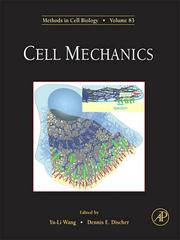| Listing 1 - 10 of 133 | << page >> |
Sort by
|

ISBN: 9780123705006 0123705002 Year: 2007 Publisher: Amsterdam : Elsevier,
Abstract | Keywords | Export | Availability | Bookmark
 Loading...
Loading...Choose an application
- Reference Manager
- EndNote
- RefWorks (Direct export to RefWorks)
Cell mechanics is the field of study that looks at how cells detect, modify, and respond to the physical properties of the cell environment. Cells communicate with each other through chemical and physical signals which are involved in a range of process from embryogenesis and wound healing to pathological conditions such as cancerous invasion. Similar principles are also likely to be critical for success in regenerative medicine. Cell mechanics is thus central to understanding these principles. As cell mechanics draws from the fields of biology, chemistry, physics, engineering, and mathematics, this book aims not only to provide a collection of research methods, but also to develop a common language among scientists who share the interest in cell mechanics but enter the field with diverse backgrounds. To this end all of the contributing authors have sought to explain in plain language the nature of the biological problems, the rationale for the approaches, in addition to the methods themselves. In addition, to balance practical utility against conceptual advances, the book has intentionally included both chapters that provide detailed recipes and those that emphasize basic principles. * Presents a distinctive emphasis on matrix mechanics and their interplay with cell functions * Includes highly significant topics relevant to basic and translational research, as well as tissue engineering * Emphasizes mechanical input and output of cells
Cells --- Biomechanics. --- Cellular Structures. --- Mechanotransduction, Cellular. --- Mechanical properties.
Book
Year: 2005 Publisher: [Place of publication not identified] Elsevier Academic Press
Abstract | Keywords | Export | Availability | Bookmark
 Loading...
Loading...Choose an application
- Reference Manager
- EndNote
- RefWorks (Direct export to RefWorks)
Acid Anhydride Hydrolases --- Cellular Structures --- Cells --- Hydrolases --- Enzymes --- Anatomy --- Enzymes and Coenzymes --- Cell Membrane --- GTP Phosphohydrolases
Book
ISBN: 9780521195447 0521195446 Year: 2010 Publisher: Cambridge : Cambridge University Press,
Abstract | Keywords | Export | Availability | Bookmark
 Loading...
Loading...Choose an application
- Reference Manager
- EndNote
- RefWorks (Direct export to RefWorks)
"Bringing to life the fascinating structures and unique mechanics of natural and biomedical cellular materials, this book is an expert guide to the subject for graduates and researchers. Arranged in three parts, it begins with a review of the mechanical properties of nature's building blocks (structural proteins, polysaccharides and minerals) and the mechanics of cellular materials. Part II then describes a wide range of cellular materials in nature: honeycomb-like materials such as wood and cork; foam-like materials including trabecular bone, plant parenchyma, coral and sponge; and composites of cellular and dense materials such as iris leaves, skulls, palm, bamboo, animal quills and plant stems. Images convey the structural similarities of different materials, whilst color property charts provide mechanical data. Part III discusses biomedical applications of cellular materials: metal foams for orthopedic applications and porous scaffolds for regenerating tissues, including the effect of scaffold properties on cell behavior"
Cytology. --- Biomedical materials. --- Foamed materials. --- Cellular Structures. --- Biocompatible Materials. --- Mousses (matériaux) --- Cytologie. --- Biomatériaux.
Book
ISBN: 9781621820383 9781621820420 Year: 2015 Publisher: Cold Spring Harbor, New York : Cold Spring Harbor Laboratory Press,
Abstract | Keywords | Export | Availability | Bookmark
 Loading...
Loading...Choose an application
- Reference Manager
- EndNote
- RefWorks (Direct export to RefWorks)
Subcellular Fractions --- Cell Fractionation --- Cellular Structures --- Cell Fractionation --- Cellules --- methods --- Methodology --- Laboratory Manuals --- Fractionnement --- Méthodologie --- Manuels de laboratoire
Periodical
ISSN: 22132953 Year: 2012 Publisher: New York : Elsevier,
Abstract | Keywords | Export | Availability | Bookmark
 Loading...
Loading...Choose an application
- Reference Manager
- EndNote
- RefWorks (Direct export to RefWorks)
Pathology, Cellular --- Cytodiagnosis --- Cytodiagnosis. --- Pathology, Cellular. --- Cellular Structures --- Cells --- Tissues --- pathology. --- Cellular pathology --- Cytopathology --- Cytologic diagnosis --- Diagnosis, Cytologic --- Diagnostic cytopathology --- Cytodiagnoses --- Pathology --- Diagnosis, Laboratory --- Cytological Techniques
Book
Year: 2005 Publisher: [Place of publication not identified] Elsevier Academic Press
Abstract | Keywords | Export | Availability | Bookmark
 Loading...
Loading...Choose an application
- Reference Manager
- EndNote
- RefWorks (Direct export to RefWorks)
Acid Anhydride Hydrolases --- Cell Physiological Processes --- Cellular Structures --- Cells --- Hydrolases --- Cell Physiological Phenomena --- Enzymes --- Anatomy --- Enzymes and Coenzymes --- GTP Phosphohydrolases --- Membrane Fusion --- Cell Membrane
Book
ISBN: 2257162196 9782257162199 Year: 2004 Publisher: Paris: Flammarion Médecine-Sciences,
Abstract | Keywords | Export | Availability | Bookmark
 Loading...
Loading...Choose an application
- Reference Manager
- EndNote
- RefWorks (Direct export to RefWorks)
Molecular biology --- Cells --- Cytology --- Molecular genetics --- Biologie moléculaire --- Cellules --- Cytologie --- Génétique moléculaire --- Cell Biology --- Molecular Biology --- Cytogenetics --- Biologie moléculaire --- Génétique moléculaire --- Molecular biology. --- Cell Cycle. --- Cell Physiological Phenomena. --- Cell Physiological Phenomena --- Cellular structures
Book
ISBN: 0123979242 0123984807 Year: 2014 Publisher: San Diego, California : Academic Press,
Abstract | Keywords | Export | Availability | Bookmark
 Loading...
Loading...Choose an application
- Reference Manager
- EndNote
- RefWorks (Direct export to RefWorks)
This new volume of Methods in Enzymology continues the legacy of this premier serial with quality chapters authored by leaders in the field. This volume covers cytoskeletal structure, including such topics as rotational movement of formins studied by fluorescence polarization microscopy, in vitro assembly assays for bacterial actin filaments, and modulators of microtubule plus end growth.Continues the legacy of this premier serial with quality chapters authored by leaders in the fieldCovers cytoskeletal structureContains chapters with such topics as rec
Contractile Proteins --- Cytoplasmic Structures --- Proteins --- Cytoplasm --- Amino Acids, Peptides, and Proteins --- Intracellular Space --- Cellular Structures --- Chemicals and Drugs --- Cells --- Anatomy --- Microtubules --- Muscle Proteins --- Cytoskeleton --- Human Anatomy & Physiology --- Health & Biological Sciences --- Neuroscience --- Clinical enzymology. --- Diagnostic enzymology --- Clinical chemistry --- Enzymology

ISBN: 1280831308 9786610831302 0199771669 9780199771660 0195129814 9780195129816 9781280831300 6610831300 Year: 2000 Publisher: New York Oxford University Press
Abstract | Keywords | Export | Availability | Bookmark
 Loading...
Loading...Choose an application
- Reference Manager
- EndNote
- RefWorks (Direct export to RefWorks)
This is a comprehensive and up-to-date survey of mental retardation caused by genes on the X chromosome. Clinical and laboratory data on 130 syndromes are presented in a concise and consistent manner. Each syndrome is defined and information is provided on somatic features, growth and development, neurological signs, cognitive performance, imaging and other laboratory findings, and when possible, the nature and localization of the responsible gene. Craniofacial and other somatic findings are extensively illustrated. A differential matrix accompanies each syndrome description to assist the reader in identifying other X-linked syndromes with overlapping features. As background, the X chromosome and the emergence of the concept of X-linked mental retardation are discussed.; X-chromosome maps show the location and mapping limits of the responsible genes. The authors have extensive experience in the clinical and laboratory delineation of X-linked mental retardation. They have described new syndromes, regionally mapped disease loci on the X chromosome, and in several cases isolated the genes responsible for X-linked syndromes.
X-linked mental retardation --- Sex Chromosome Disorders --- X Chromosome --- Genetic Diseases, Inborn --- Sex Chromosomes --- Chromosome Disorders --- Congenital, Hereditary, and Neonatal Diseases and Abnormalities --- Chromosomes --- Diseases --- Congenital Abnormalities --- Cellular Structures --- Genetic Structures --- Genetic Phenomena --- Cells --- Anatomy --- X-linked Intellectual disability

ISBN: 0896032361 1592595065 9780896032361 Year: 1993 Volume: 19 Publisher: Totowa, N.J. Humana
Abstract | Keywords | Export | Availability | Bookmark
 Loading...
Loading...Choose an application
- Reference Manager
- EndNote
- RefWorks (Direct export to RefWorks)
Molecular biology --- Membranes (Biology) --- Research --- Methodology --- Membrane Lipids --- Membrane Proteins --- Cell Membrane --- Lipids --- Proteins --- Cellular Structures --- Amino Acids, Peptides, and Proteins --- Cells --- Chemicals and Drugs --- Anatomy --- Cytology --- Biology --- Health & Biological Sciences --- Life sciences. --- Cell biology. --- Life Sciences. --- Cell Biology. --- Cell biology --- Cellular biology --- Cytologists --- Biosciences --- Sciences, Life --- Science --- Cytology. --- Membranes (Biology) - Research - Methodology
| Listing 1 - 10 of 133 | << page >> |
Sort by
|

 Search
Search Feedback
Feedback About UniCat
About UniCat  Help
Help News
News